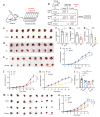Exercise accelerates recruitment of CD8+ T cell to promotes anti-tumor immunity in lung cancer via epinephrine
- PMID: 38622609
- PMCID: PMC11021002
- DOI: 10.1186/s12885-024-12224-7
Exercise accelerates recruitment of CD8+ T cell to promotes anti-tumor immunity in lung cancer via epinephrine
Abstract
Background and purpose: In recent years, there has been extensive research on the role of exercise as an adjunctive therapy for cancer. However, the potential mechanisms underlying the anti-tumor therapy of exercise in lung cancer remain to be fully elucidated. As such, our study aims to confirm whether exercise-induced elevation of epinephrine can accelerate CD8+ T cell recruitment through modulation of chemokines and thus ultimately inhibit tumor progression.
Method: C57BL/6 mice were subcutaneously inoculated with Lewis lung cancer cells (LLCs) to establish a subcutaneous tumor model. The tumor mice were randomly divided into different groups to performed a moderate-intensity exercise program on a treadmill for 5 consecutive days a week, 45 min a day. The blood samples and tumor tissues were collected after exercise for IHC, RT-qPCR, ELISA and Western blot. In addition, another group of mice received daily epinephrine treatment for two weeks (0.05 mg/mL, 200 µL i.p.) (EPI, n = 8) to replicate the effects of exercise on tumors in vivo. Lewis lung cancer cells were treated with different concentrations of epinephrine (0, 5, 10, 20 µM) to detect the effect of epinephrine on chemokine levels via ELISA and RT-qPCR.
Results: This study reveals that both pre- and post-cancer exercise effectively impede the tumor progression. Exercise led to an increase in EPI levels and the infiltration of CD8+ T cell into the lung tumor. Exercise-induced elevation of EPI is involved in the regulation of Ccl5 and Cxcl10 levels further leading to enhanced CD8+ T cell infiltration and ultimately inhibiting tumor progression.
Conclusion: Exercise training enhance the anti-tumor immunity of lung cancer individuals. These findings will provide valuable insights for the future application of exercise therapy in clinical practice.
Keywords: Ccl5; Cxcl10; Epinephrine; Exercise; Lung cancer.
© 2024. The Author(s).
Conflict of interest statement
The authors declare no competing interests.
Figures






References
MeSH terms
Substances
Grants and funding
- hlqm12023023/2023 Postgraduate Youth Training Program of School of Nursing, Anhui Medical University
- hlqm12023001/2023 Postgraduate Youth Training Program of School of Nursing, Anhui Medical University
- 82002450/National Natural Science Foundation of China
- 2020xkjT023/Basic and Clinical Collaborative Research Enhancement Program
- hlpy20210013/the Breeding Foundation of Nursing School
LinkOut - more resources
Full Text Sources
Medical
Research Materials

